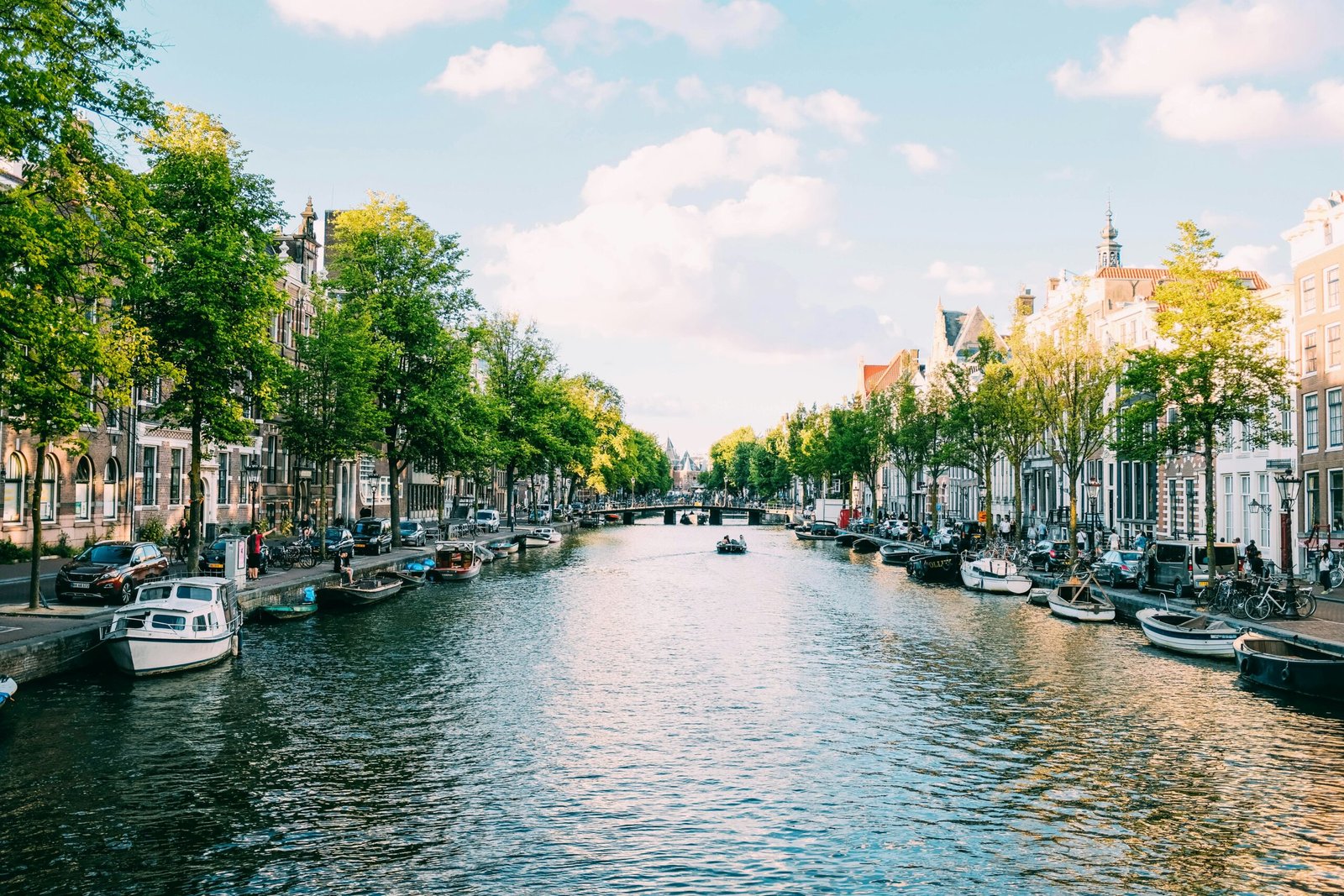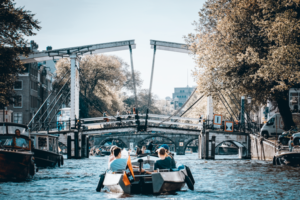
The History of the Amsterdam
Red Light District
From its meager beginnings, the Eight Years War, the Dutch Golden Age, and up until today, Amsterdam has always had working girls taking care of people’s most carnal needs.
Amsterdam’s Red Light District, located in a neighborhood called De Wallen, is a famous and well-visited location today but it was also a popular destination for most of Amsterdam’s history. Since the very beginnings of the city’s history, the red light district has been home to part of Amsterdam’s harbor district. When you consider that Amsterdam grew to prominence as a maritime trade city, the connection between its former harbor and the current area known for is prostitution, is clear.
Prostitution is just a small part of the topic we will explore in this post.
If you are looking to learn about Amsterdam’s Red Light District today, in all its partying and prostitution glory, head to the previous post in this series. Part 1: the Amsterdam Red Light District of today, including what it is, its location, times to visit, how it works, and a little more information about prostitution in Amsterdam.
This post, however, plans to go in-depth into an aspect of the Red Light District that not many people are aware of, its historical significance. My hopes are that when you wander the streets of the Amsterdam Red Light District, you will be able to look past its gritty modern exterior and peer into the deeper heart of what this area means to Amsterdam.
Table of Contents
A timeline of Amsterdam's History
One of the best things any visitor can do before reaching the destination of their visit is to dip their toes into the history of that place and its people. The reason for this is that even a short read of a Wikipedia entry can provide a better perspective from which to understand and enjoy your visit even more.
For instance, the reasons why Amsterdam has so many canals, its tolerance to drugs and prostitution, and why the beautiful canal houses are all so narrow, can be understood from a quick read. It is for this exact reason we will briefly take you through some important periods of Amsterdam’s history.
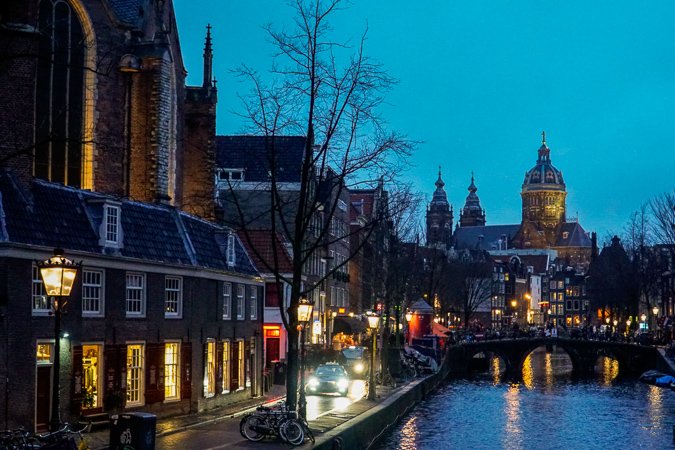
Amsterdam’s modest beginnings
Amsterdam is actually a rather young city for the Netherlands. Sometime in the late 10th century is generally regarded as the time the land around Amsterdam was reclaimed by local inhabitants and settled. The expression goes, “God created the Earth and the Dutch created the Netherlands.”
In the 1200s, the locals around the Amstel river built a bridge and dam across the river giving the village the name Aemstelredamme. Literally meaning “dam of the people living along the Amstel River.” Dam Square is the site this dam. In the early 1300s, the city’s name developed into Amsterdam and it eventually gained city rights.
Amsterdam’s rise to prominence
Interestingly, Amsterdam’s rise to prominence as a mercantile city is a direct result of a natural disaster.
On December 14th, 1287, the day after Saint Lucia’s Day, a powerful windstorm coinciding with a high tide caused a massive storm surge. This storm surge was able to break through a series of sand and boulder clay barriers to flood the low-lying peatlands and freshwater lake, to form the salty Zuiderzee.
The creation of this shallow sea (now called the Ijsselmeer) gave Amsterdam a direct route to the North Sea and the lucrative trade routes of the Hanseatic League of the Baltic. The St. Lucia’s Day Flood, while having been one of the deadliest floods in world history, almost immediately triggered the rise of Amsterdam.
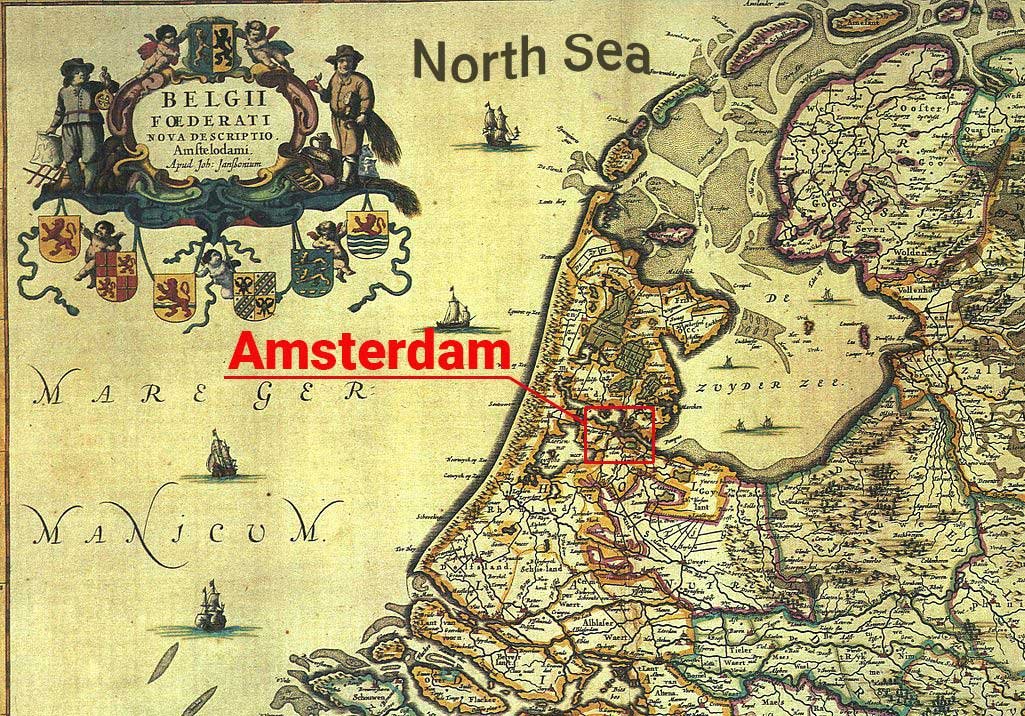
Amsterdam’s first taste of fame
In 1345, the Eucharistic miracle made Amsterdam an important site of pilgrimage. The story of the miracle was that a priest was called to give a dying man his last rites. The man was given the host but due to being ill, he later vomited up the host which the maid threw onto the fire. The host did not burn, turning the house into a miracle site.
People were a lot more religious back then and the city became a popular destination for religious tourism, attracting up to 90,000 people a year at its peak.
The Eighty Years’ War
From 1568 to 1648, the seventeen provinces of modern-day Belgium, Netherlands and Luxembourg revolted against the new taxes and religious persecution of Protestants by Philip II of Spain. The rift between Protestants and Catholics, and their Habsburgs rulers, fueled the Eighty Years’ War, resulting in Dutch independence from Spain, and contributed heavily to Amsterdam’s growth and success.
The main contributor to this success was the Sack of Antwerp (or the Spanish Fury) which dethroned Antwerp as a major trading city and led to a nearly complete brain-drain of (Protestant Huguenot) talent, intellect, and entrepreneurial spirit. Those intelligent people went to Amsterdam, a city famed for its tolerance. This period kicked off the Dutch Golden Age.

The Dutch Golden Age
The Dutch Golden Age lasted nearly 100 years from 1588 to 1672.
During this time trade, science, art, and Dutch military prowess flourish, with Amsterdam at the center of it all. Amsterdam’s wealth came primarily through maritime trade via the famous Vereenigde Oost Indische Compagnie (VOC) or the Dutch East India Company. The world’s first stock exchange was created which was fundamental in generating the capital needed to fund the expeditions to establish trade in the spice islands.
This early stock exchange was crucial to the rise of Dutch maritime trade as groups of people could buy a stake in an expedition rather than one super-wealthy individual or the state needing to solely take on the risk of its failure. This risk mitigation meant that funding such expeditions was attractive to the middle class. This eventually allowed the Dutch to account for a little more than half of the European trade tonnage during this period. This massive amount of trade created a lot of wealth that was spread through the middle class. This started the artistic, scientific, and architectural movement of Amsterdam as more people could afford large houses, libraries of books, and artists to paint whatever their patrons desired.
Amsterdam became the wealthiest city in the Western world and nearly everything that makes Amsterdam iconic today – its canals, houses, and masterpieces filling the museums – were made during or as the result of the Dutch Golden Age.
With maritime trade being the backbone of the Dutch Golden Age, this means that the harbor area was the most important location in the city.
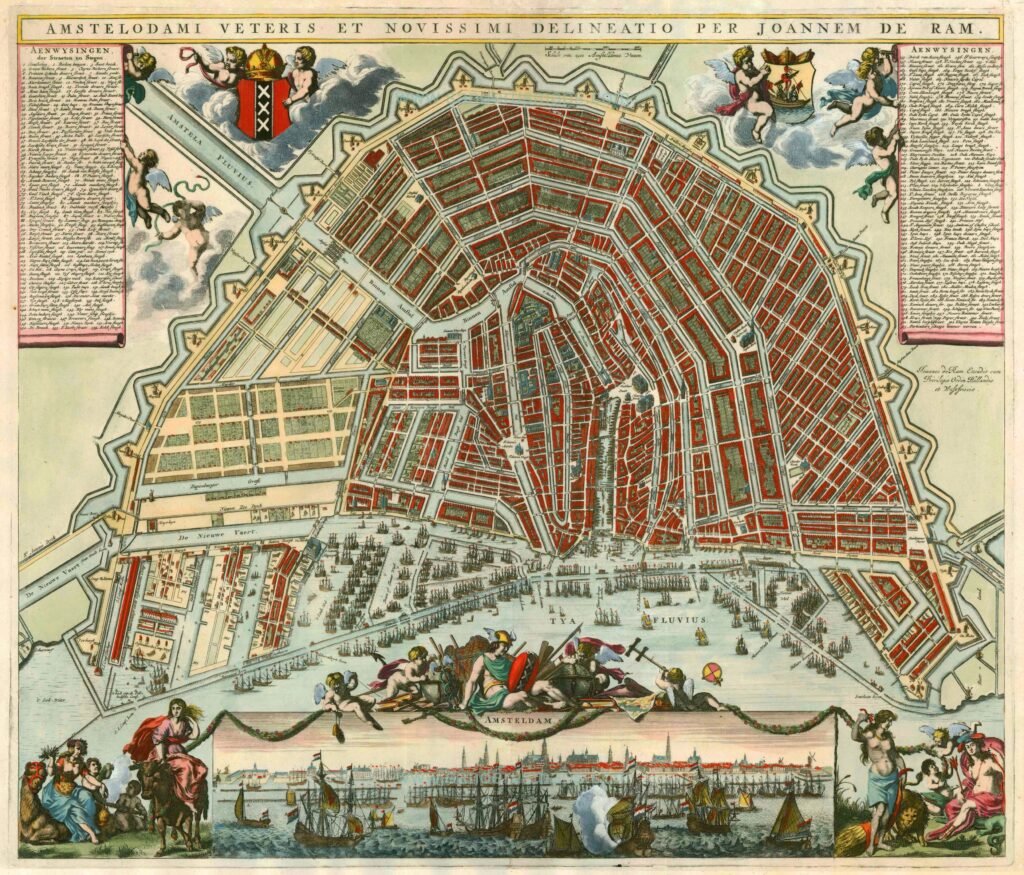
The decline into modernization
All good things must come to an end and the Dutch Golden Age is no different.
Around the turn of the 18th century the Dutch Republic started to fall from prominence as the English started to wrest away control of the seas and the Dutch East India Company (VOC) was outcompeted. On the European continent, the Netherlands was almost completely invaded by French and German forces and was also internally divided into two factions, royalists and nationalists. The Dutch would push back the invaders but were never able to recover their former glory.
During this time Amsterdam started to expand outside of its Canal Belt in the “centrum” district of the city, as large public works were undertaken to reduce unemployment and relieve the housing shortages in the city.
Amsterdam Today
Today, Amsterdam is a popular tourist destination and much of Amsterdam’s appeal is related to its success in previous centuries.
Its beautiful canals and architecturally unique canal houses are the results of its Golden Age. Amsterdam’s reputation as a tolerant city for drugs, prostitution, and homosexuality is directly a result of its continuing struggle against the seas, its Calvinistic religious views, and its need to get along with people from different cultures for financial gain.
Amsterdam’s early proclivity for capitalism and scientific innovation has continued to make the Netherlands and Amsterdam a popular location for business. Many multinational organizations have their European headquarters in Amsterdam and this has created a city with a diverse and exciting cultural makeup.
Why is there a Red Light District in Amsterdam?
Now that we’ve explored Amsterdam’s history and the role maritime trade played in that history, let’s return our focus to the Amsterdam Red Light District. The rise of Amsterdam to world prominence was fueled by trade. Trade that would have passed through the oldest part of the city, its harbor.
What’s a returning sailor to do with a fist full of cash and an itch for female companionship after months at sea with only men?
Get drunk and get laid.
Amsterdam’s Red Light District dates back to the 15th century when it operated in the same area but on slightly different streets. During this time Amsterdam was making a name for itself through sea trade which meant that there were a lot of men leaving for and returning from long voyages. So, with a need to be fulfilled and a convenient location right next to the port, one of Amsterdam’s oldest neighborhoods became the long-time home of one of civilization’s oldest professions.
The 15th, 16th, and 17th centuries were dangerous times and sailing was even more life-threatening. With a city whose main industry would have been maritime trade, you can imagine that many prostitutes may have started in the profession due to becoming widowed. As many as one-third to one-half of sailors died during sea voyages. With so many widowed women at a time when women didn’t have many options for employment, prostitution would have been a difficult but necessary choice.
The local name for the Red Light District
Amsterdam’s Red Light District is known as “De Wallen.”
This is actually the name of the largest and most well-known section as there are two other smaller Red Light areas in Amsterdam. See my other article about the Red Light District of Today for a map [link to].
If you are wondering what the name of the neighborhood “De Wallen” means, it is literally translated as “The Walls.” This refers to the defensive walls constructed around the early city, and where the neighborhood was nestled up against. In the 13th century, De Wallen was situated around the Oude Kerk (Old Church) and the street, Warmoesstraat. Both of these places still exist, with the Oude Kerk still hanging on to its medieval charms despite the party atmosphere of its surroundings. The Warmoesstraat however is a busy tourist street where you would be hard-pressed to find anything of historical value.
As the centuries passed, the city expanded, the defensive walls moved outward, and the harbor moved northwest to the location of the present-day Centraal Train Station. However, the nickname still persists.
Historical sites in the Red Light District
Most tourists who walk around the Red Light District are simply unaware of its past, but you, by virtue of having read this article can now appreciate the easily overlooked past of this area of Amsterdam. If the history of the Red Light District interests you, please take the time to explore some of these historical sites in the area.
De Oude Kerk
De Oude Kerk (or “Old Church”) is Amsterdam’s oldest building, dating back to 1306, and holds a rich history as a place of worship and a center for community life. Its beautiful Gothic architecture, mesmerizing stained-glass windows, and ornate carvings make it a must-visit for tourists. Additionally, it now serves as a venue for contemporary art exhibitions and cultural events, blending history with modern creativity.
Address: Oudekerksplein 23, 1012 GX
Onze Lieve Heer Op Solder
Meaning “Our Dear Lord in the Attic,” this hidden gem is a 17th-century canal house that conceals a secret Catholic church in its attic. Onze Lieve Heer Op Solder provides a unique glimpse into the religious history of Amsterdam during the time when Catholicism was suppressed. The museum showcases the well-preserved church, historic rooms, and a collection of religious artifacts.
Address: Oudezijds Voorburgwal 40, 1012 GE
De Waag
De Waag is a medieval fortress gate turned into a grand, historic building that once served as a weigh house and guildhall. Its stunning architecture, dating back to the 15th century, makes it an essential stop for tourists. Today, De Waag houses a popular restaurant, allowing visitors to dine in an atmospheric and historically significant setting.
Address: Nieuwmarkt 4, 1012 CR
Schreierstoren
Schreierstoren is a 15th-century defensive tower that was once part of the old city wall of Amsterdam. Its name, which translates to “Weeping Tower,” is believed to come from the wives who would bid farewell to their seafaring husbands from its location. The tower’s rich history and unique architecture make it a fascinating site for visitors to explore.
Address: Prins Hendrikkade 94-95, 1012 AE
Wynand Fockink
Wynand Fockink is a historic distillery and tasting room established in 1679, renowned for its traditional Dutch liqueurs and genevers. Tourists can experience the rich heritage of Dutch spirits, learn about the distilling process, and sample a variety of unique flavors in a charming, authentic environment.
Address: Pijlsteeg 31, 1012 HH
Het Trippenhuis
Het Trippenhuis is a stunning 17th-century canal house built for the wealthy Trip family. Its impressive and ornate facade is one of the finest examples of Dutch Classicism. The building currently houses the Royal Netherlands Academy of Arts and Sciences, and its exterior is worth admiring during a leisurely stroll through the city.
Address: Kloveniersburgwal 29, 1011 JV Amsterdam, Netherlands
Beurs van Berlage
Beurs van Berlage is a historic stock exchange building designed by renowned architect Hendrik Petrus Berlage in 1903. Its striking architecture and significance in the financial history of Amsterdam make it an interesting site for visitors. Today, the building serves as a conference center and exhibition space, hosting various events and art exhibitions.
Address: Damrak 243, 1012 ZJ
Basilica of Saint Nicholas
The Basilica of Saint Nicholas is a prominent Catholic church built in the 19th century, showcasing an impressive neo-Baroque and neo-Renaissance architectural style. The church features stunning stained glass windows, intricate decorations, and an organ that dates back to 1889. This historical monument offers a peaceful retreat for visitors amidst the bustling city.
Address: Prins Hendrikkade 73, 1012 AD
Het Oost-Indisch Huis
Het Oost-Indisch Huis, or the East India House, is a historic building that served as the headquarters of the Dutch East India Company (VOC) in the 17th century. Visitors can admire the Dutch Renaissance architecture and learn about the influence of the VOC on global trade and Amsterdam’s Golden Age.
Address: Kloveniersburgwal 48, 1012 CX
Museum van Loon
Museum van Loon is a 17th-century canal house turned museum, providing visitors with a glimpse into the lives of the wealthy Dutch merchant class during the Golden Age. The museum boasts a stunning collection of furniture, paintings, and silverware, as well as a beautifully preserved garden, offering a serene escape from the city.
Address: Keizersgracht 672, 1017 ET


